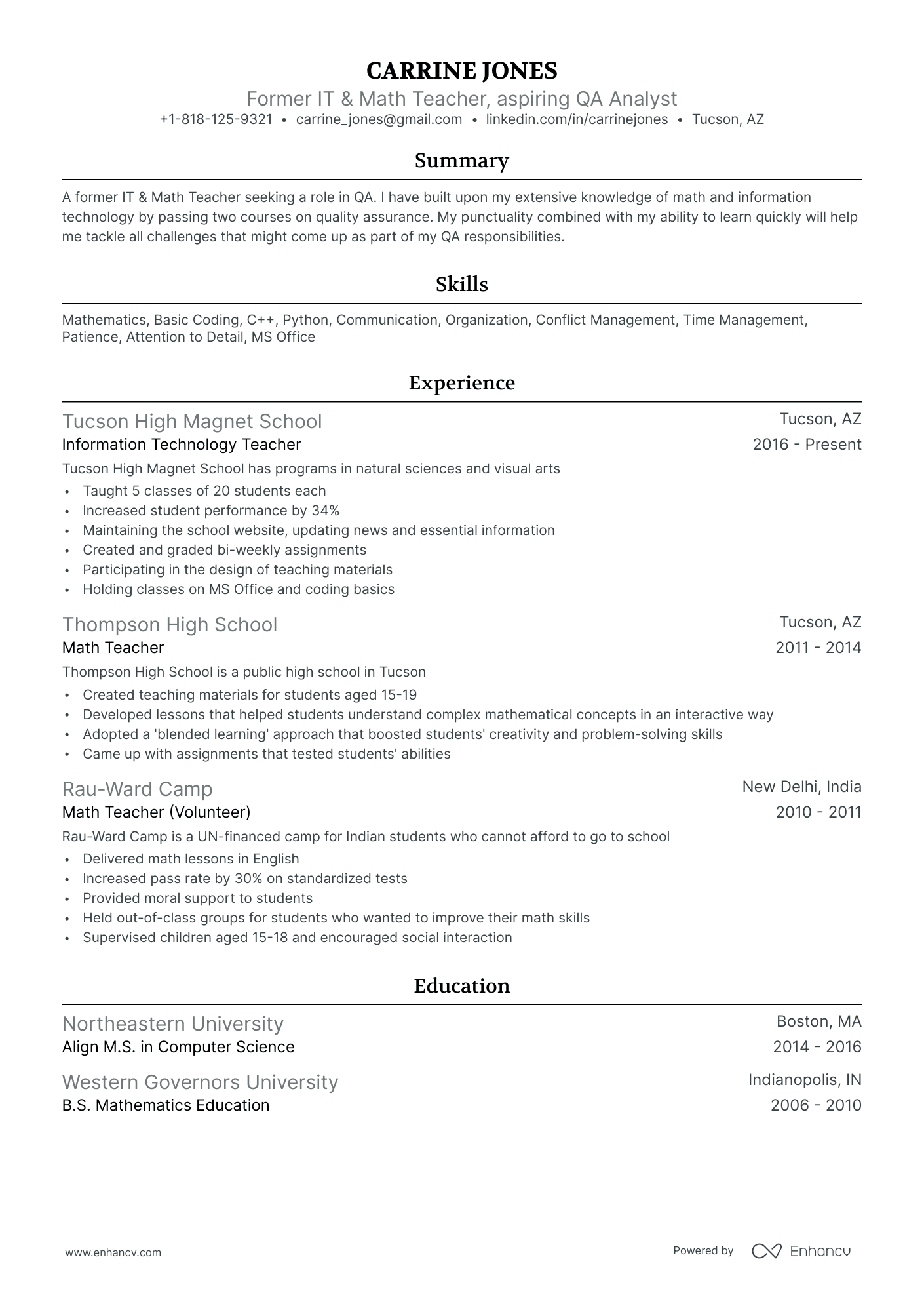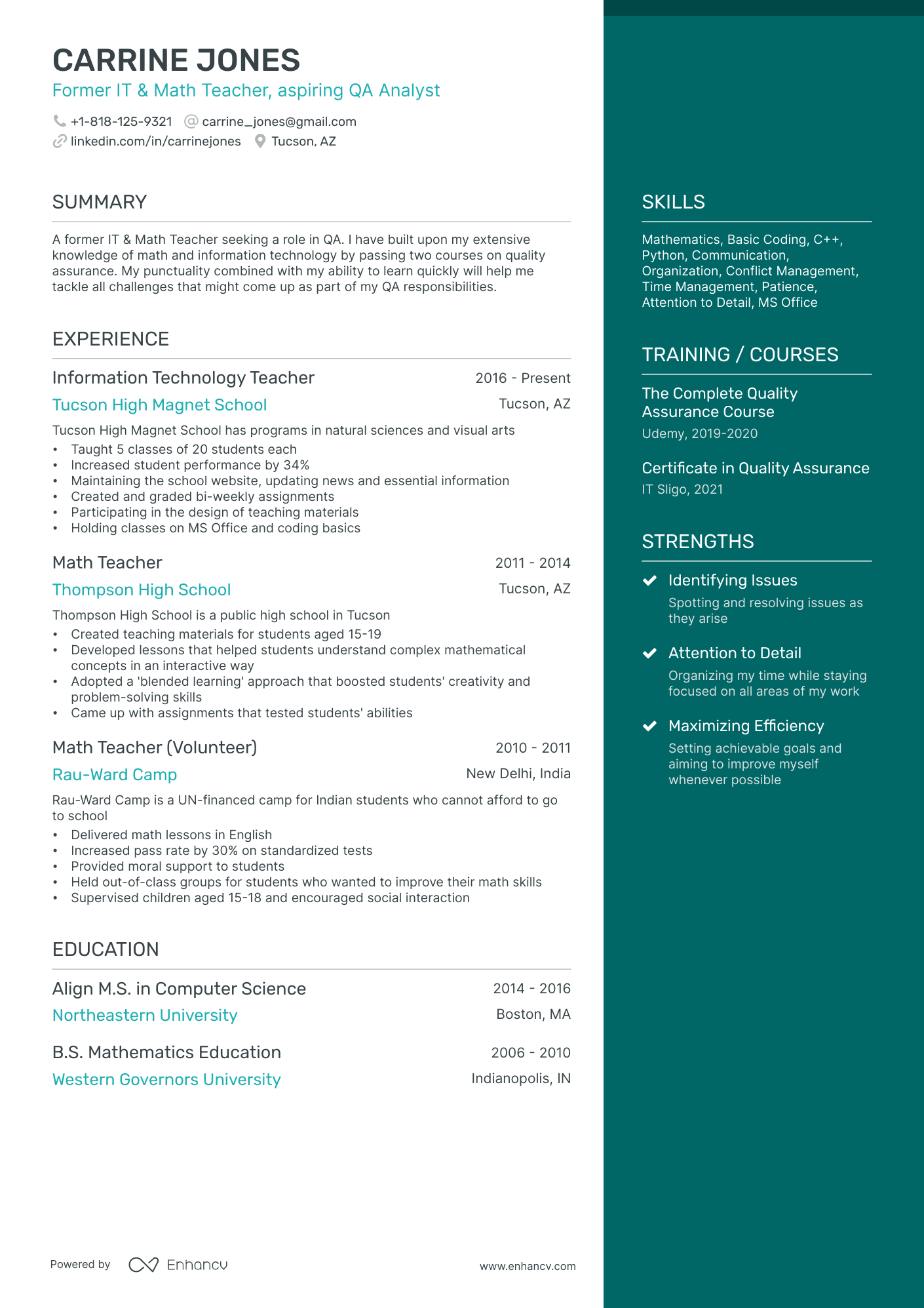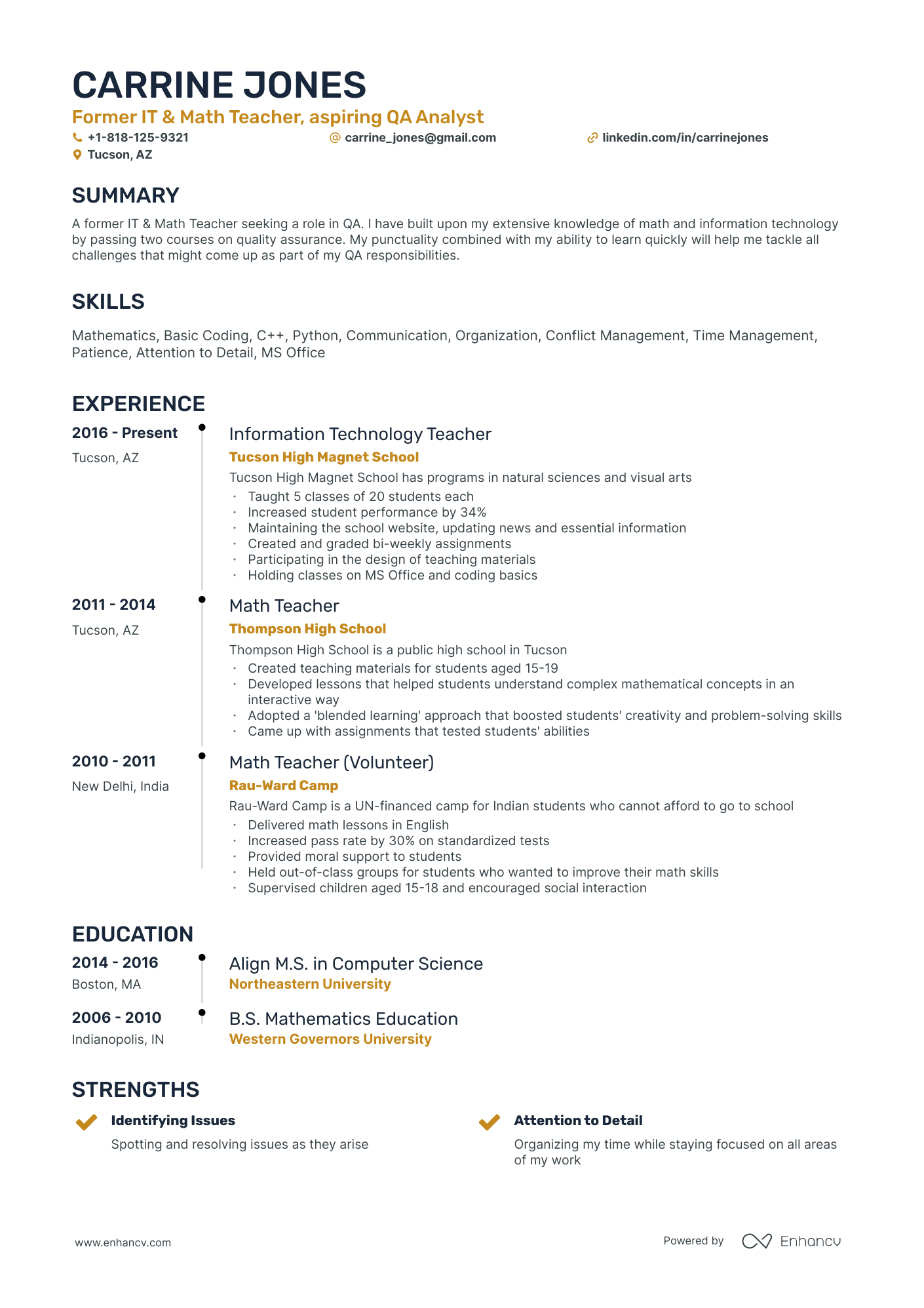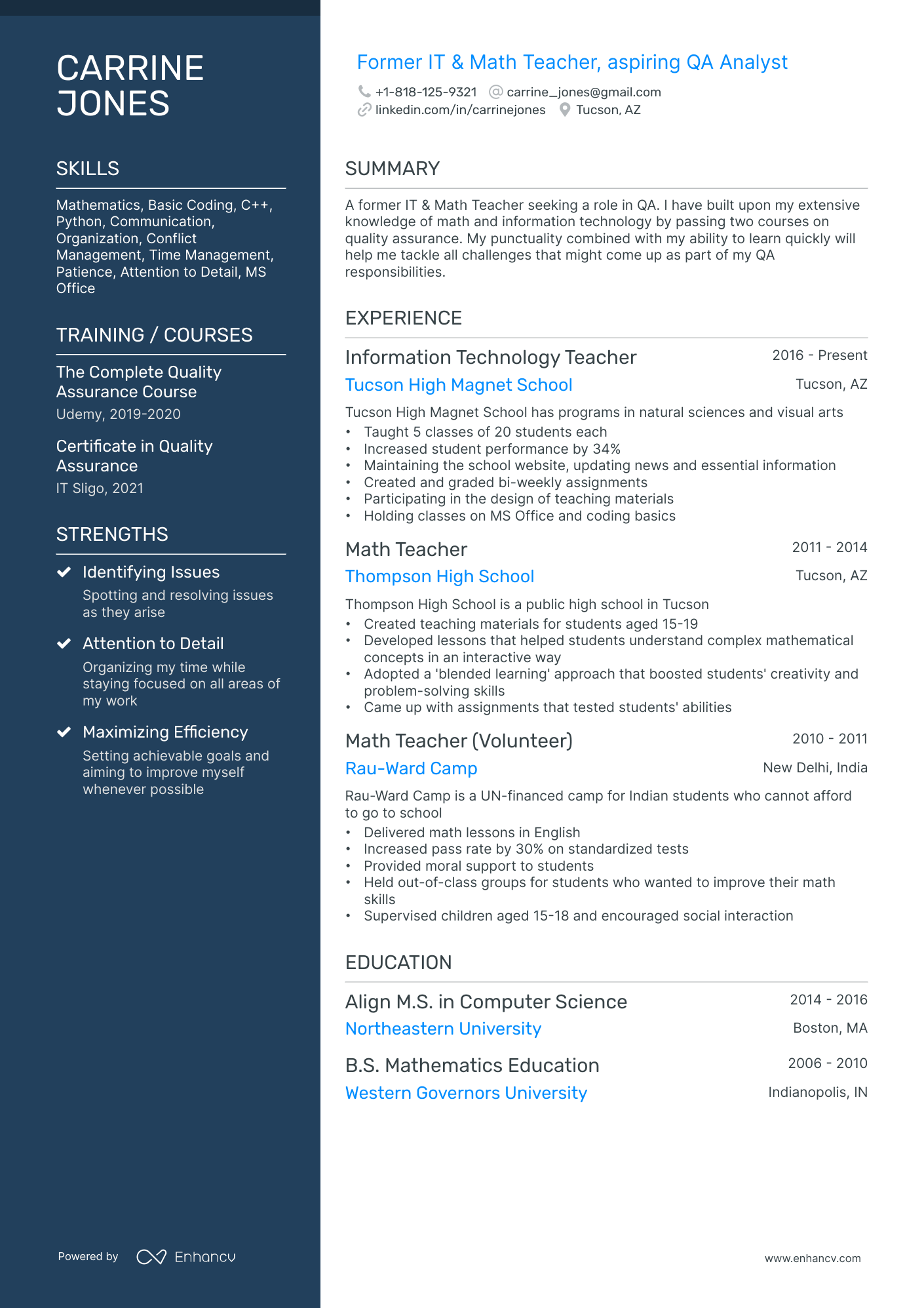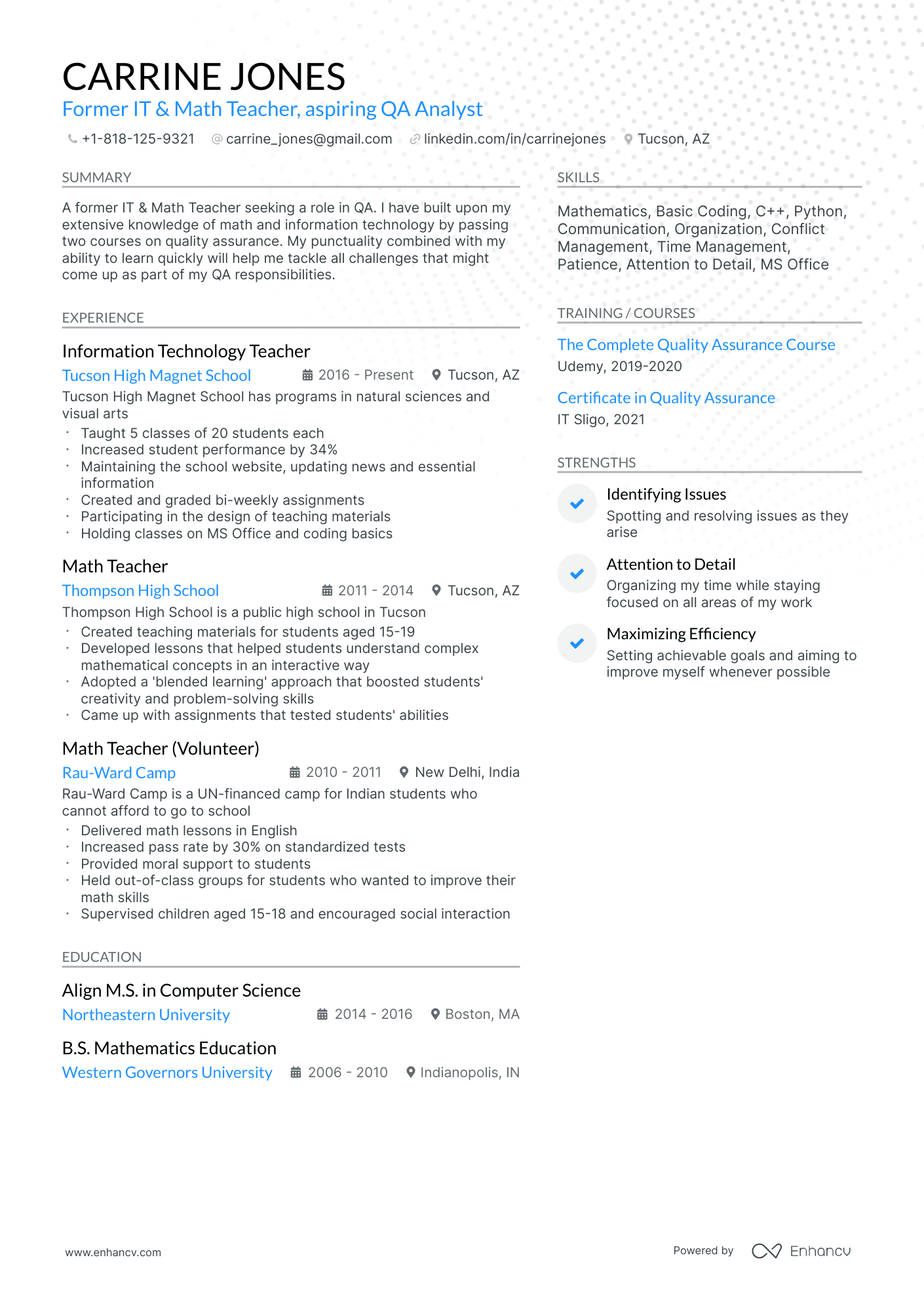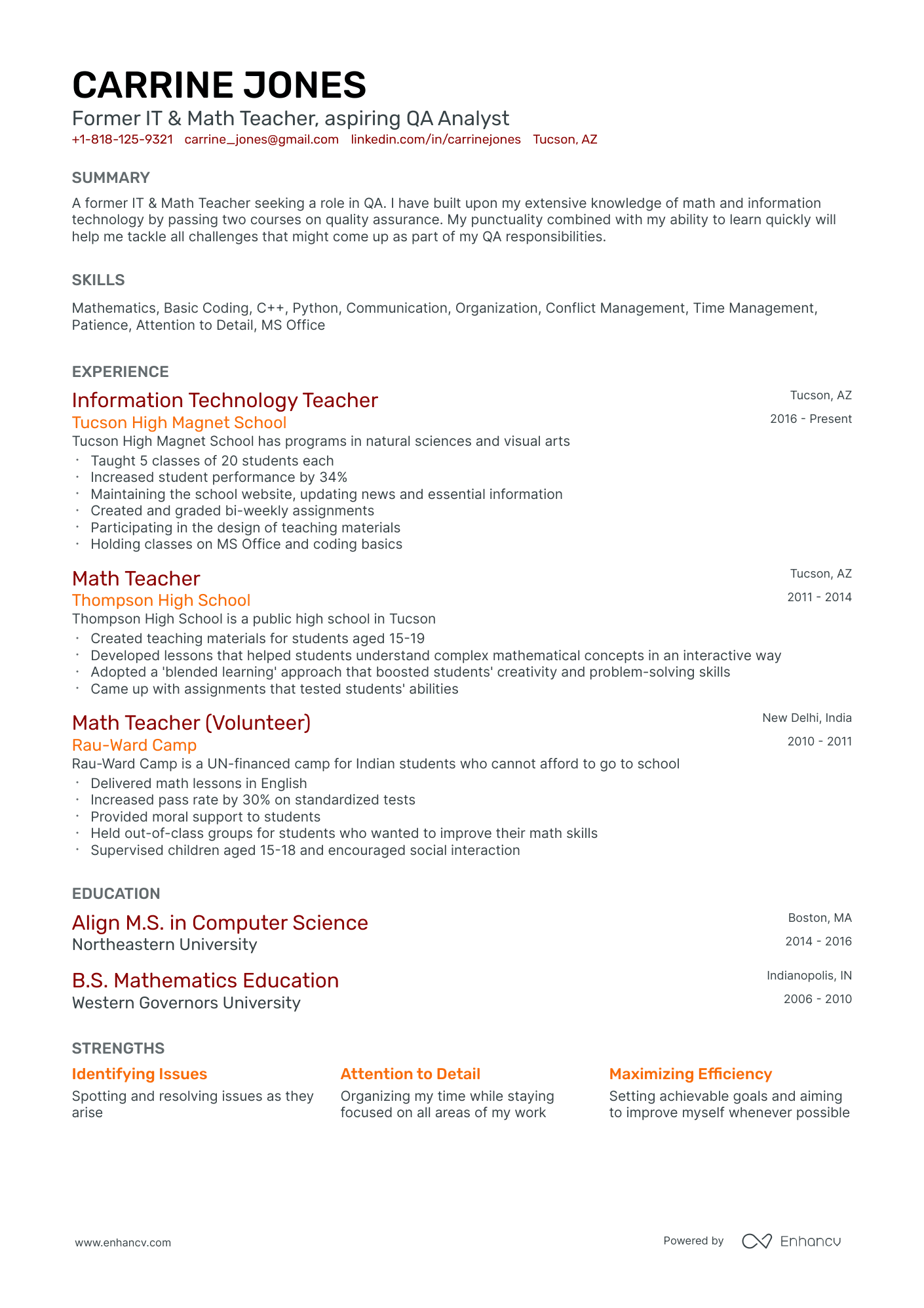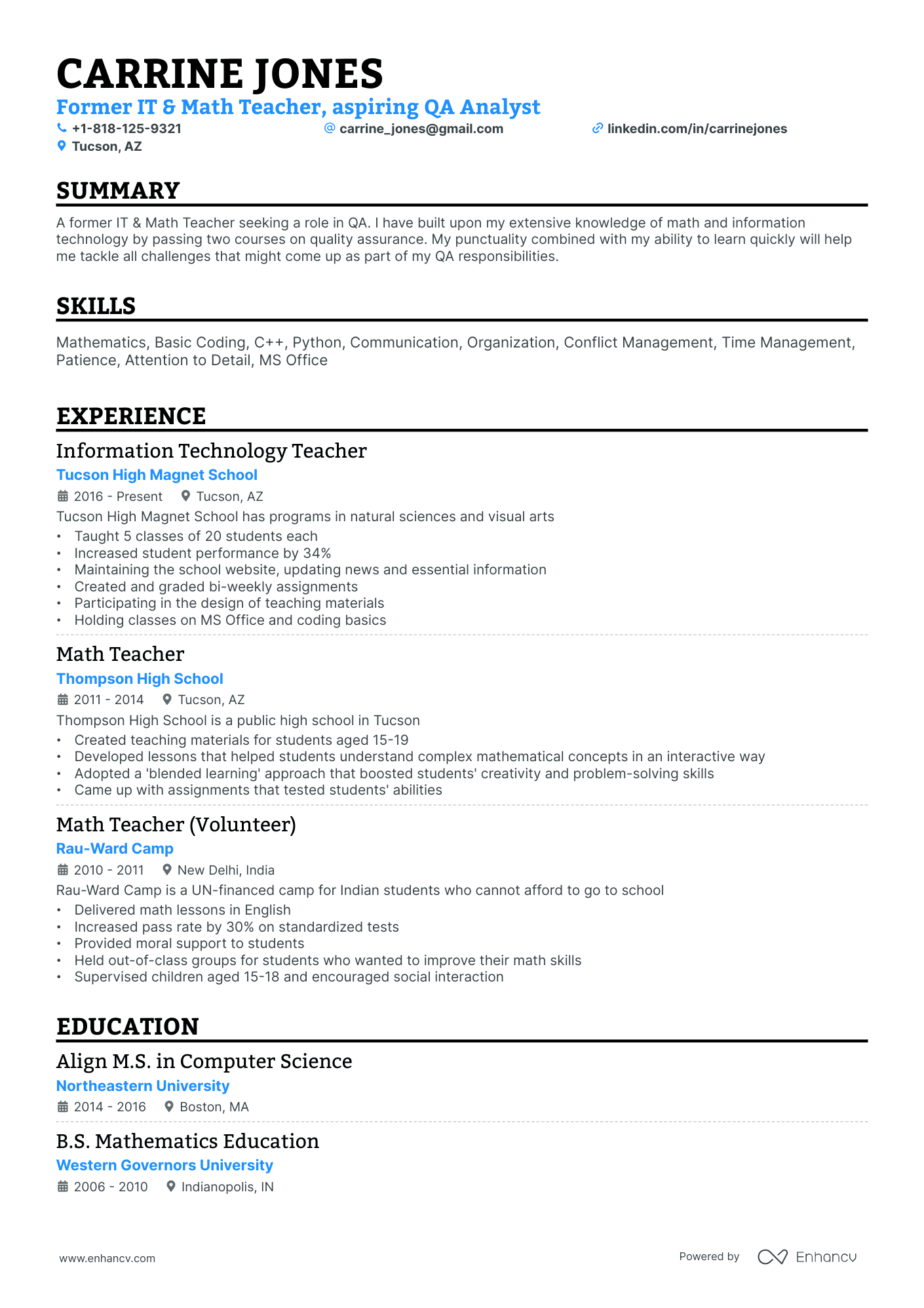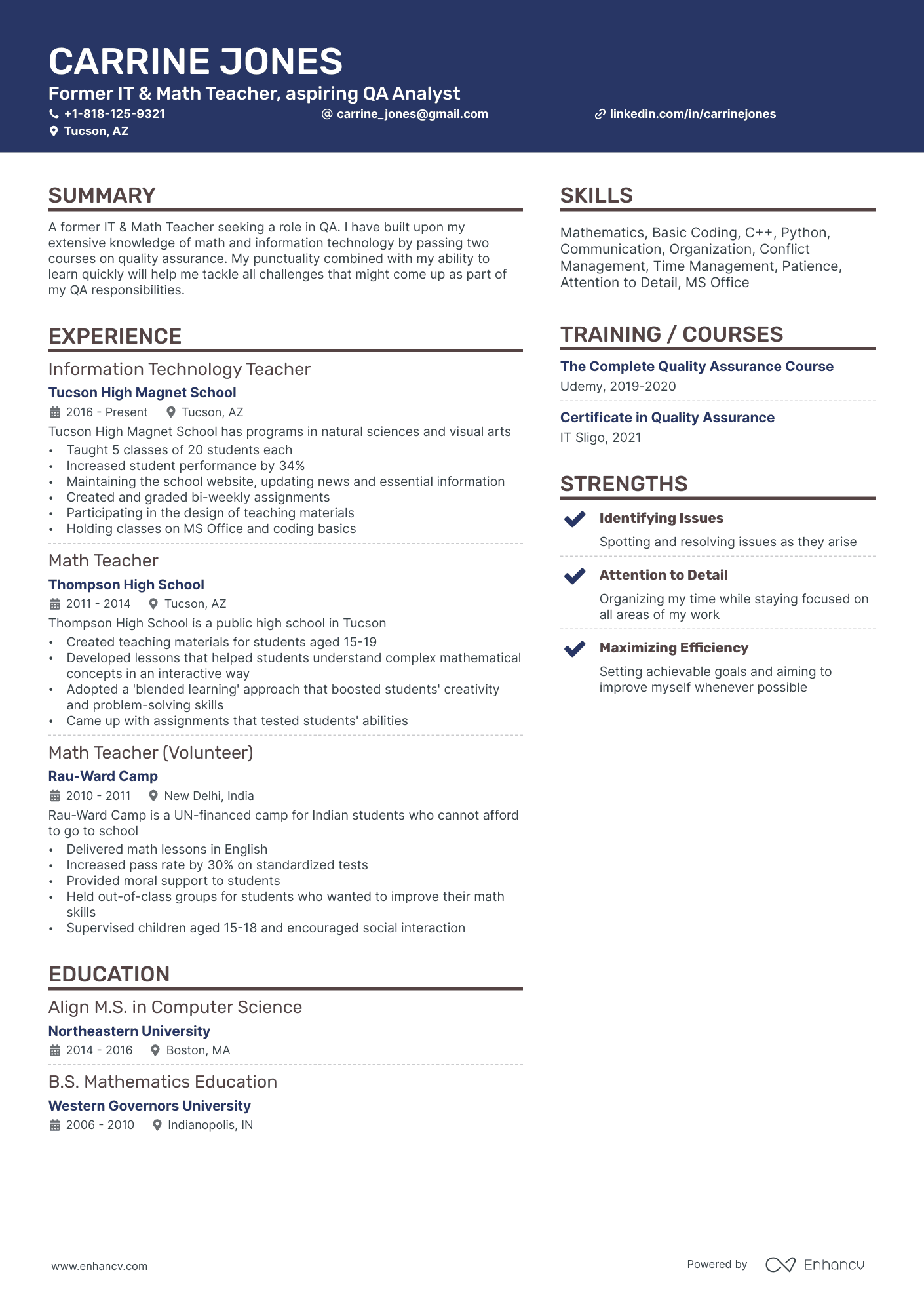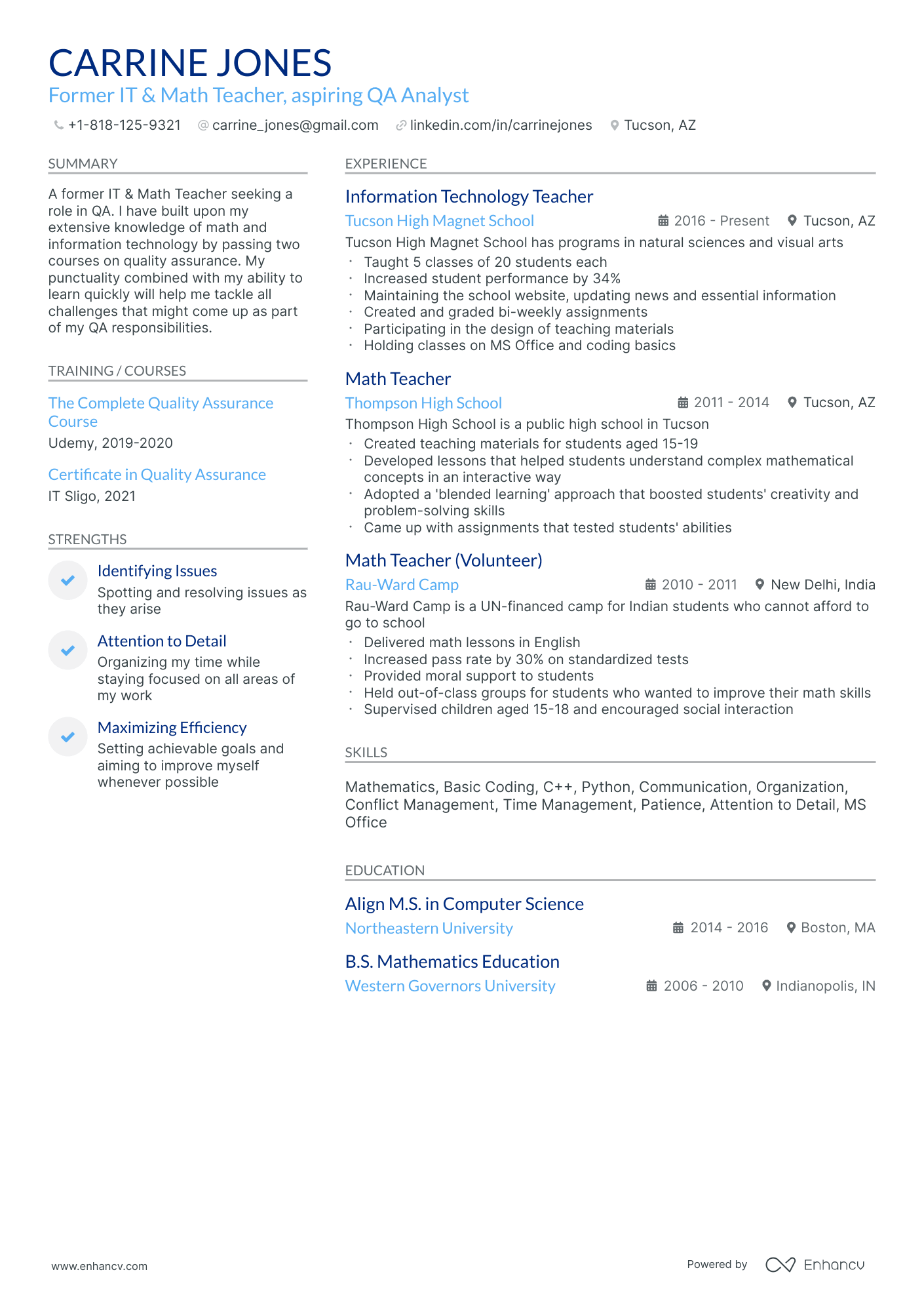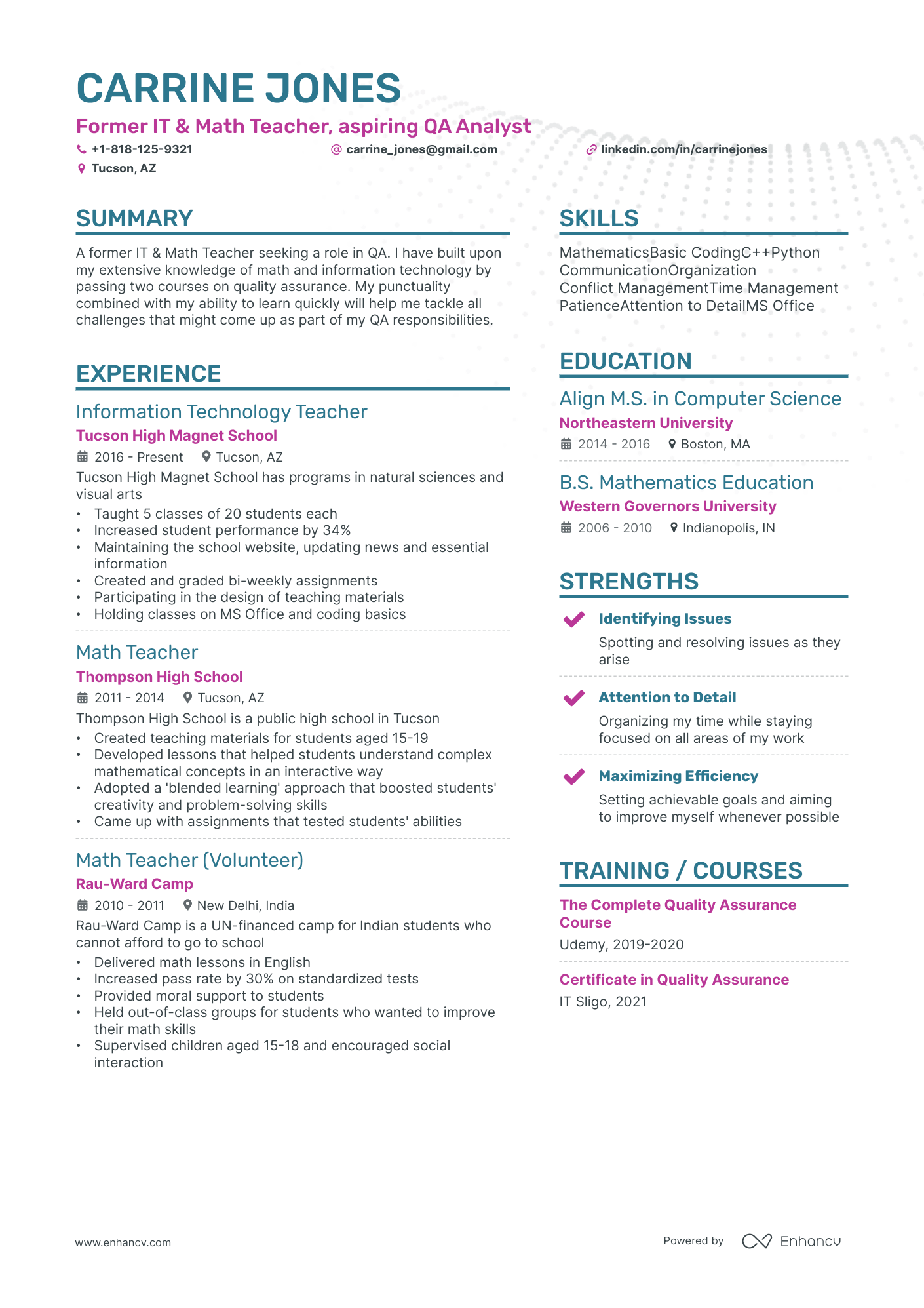Teacher burnout is no joke.
You’ve probably considered changing your career for a while now.
Yet, how do you overcome the stereotypes that go with being “just” a teacher? How do you prove that you can thrive in a different industry?
Continue reading to find out how to:
- Adapt your teacher career change resume for various other roles;
- Use our teacher career change resume example to craft your own;
- Draw inspiration from side projects and hobbies to build your experience section.
Once you figure out the writing process, come back to check out our job-specific guides:
Teacher career change resume example
- Effectively Showcasing Relevant Skills: By bringing the “Attention to Detail” and “Basic coding” skills to the forefront, the applicant bridges the gap between teaching and QA roles.
- Emphasizing a Drive for Continuous Learning: Including recent role-related training you’ve completed (be it from Udemy or IT Sligo) demonstrates your commitment to transitioning to the QA field.
- Highlighting Quantifiable Achievements in Teaching: The candidate successfully proves they know how to measure the impact of their work. Numbers and data speak louder than any buzzwords.
- Affirm Your Experience with Technology in Education: Having a solid foundational knowledge of coding basics makes the applicant the perfect candidate for a QA Analyst.
How to format a teacher career change resume
Even if your academic specialization isn’t Literature, you have an appreciation for good organization.
Such as a neat and concise mathematical solution. Or a well-structured code.
Resume writing is no different. You have to make the most of each section by emphasizing your key achievements and skills.
To do that, consider the following writing tips:
- Stick to the reverse-chronological resume format, it’s a recruiters’ favorite. Make sure to draw role-relevant experiences from each of your past teaching positions.
- Take advantage of the extra space in your resume header. Link to other professional profiles you have or a portfolio pertinent to the position. For instance, share your GitHub, if you’re aiming for an IT-related job.
- Build a strong resume objective. If you have no practical experience in your target industry, appeal to companies by strategically pointing to relevant transferable skills.
- Don’t underestimate the education and talent sections. While some positions require a specific degree, other jobs, such as a QA Analyst, have a low-entry threshold. Describe any relevant training you’ve undergone.
- Limit your resume to a maximum of 2 pages. Grab recruiters' attention from the get-go. Regardless of your new career path, hiring managers spend no more than 7 seconds on any given resume.
- Save your information as a PDF document, unless otherwise instructed. This file type is best at preserving the formatting of your resume. And it’s Applicant Tracking System-friendly (ATS).
- Ensure you use a readable font, such as Lato or Raleway. But any other serif and sans-serif font works just as well.
Keep in mind these are general formatting recommendations. Always check for any extra requirements present within the business niche and the job ad.
Some industry leaders have additional company-specific rules of their own.
For example, Google recruiters request applicants to bolden the names of tools and programming languages within the resume.
So, be vigilant.
It’s best to prepare a different resume for each of the roles you’ve targeted.
Consider your target market – resumes in Canada, for example, follow different layout conventions.
Is your resume good enough?
Drop your resume here or choose a file. PDF & DOCX only. Max 2MB file size.
The top sections on a teacher career change resume:
- Summary: Showcasing how your accomplishments and transferable skills align with your potential employer’s goals is crucial. It highlights your aspirations for a career change. And the work you’ve put into doing so.
- Skills: Separate yourself from the stereotype of the “all theory, no practice” teacher. As a professional transitioning to another industry, you must emphasize your role-relevant transferable talents.
- Experience: Demonstrate how your teaching experience can be beneficial in your new career path by mentioning pertinent achievements.
- Education: List relevant degrees and certifications to prove you’re no stranger to the business niche and you’re aware of current industry trends.
- Training/Courses: Direct recruiters’ attention to your strive for learning by displaying all the new abilities you acquired in preparation for your career change.
What recruiters want to see on your resume:
- Transferable Skills: Hiring managers want to know how much of your skill set applies to the new role.
- Adaptability: Convince recruiters that your transition from the education sector to your industry of choice is going to be smooth.
- Continuous Learning: Showcase your determination to do well on your new career path by providing evidence of ongoing training.
- Relevant Experience: Include any pertinent non-teaching side projects, volunteer work, or practical experiences to show the full scope of your abilities.
- Achievement Metrics: Explain how your teaching work made an impact on your students by quantifying your achievements.
How to write your teacher career change resume experience
As its name suggests, the resume experience section is where you detail your professional expertise.
It’s tempting not to describe your work history in full if you fear teaching will lower your chances of getting the job.
But you’re robbing yourself of the great opportunity to align your accomplishments and talents with the available position.
That’s why, when building your experience entries, refrain from listing teaching duties and responsibilities.
Instead, shift the focus toward how your career has progressed so far. Share pertinent and measurable achievements that demonstrate the impact of your work.
Describe how your actions have affected your students, their parents, and even other teachers.
But more importantly, relate your work experience to the role you desire.
The best way to do this is to think of professional challenges you’ve overcome and explain how you did it.
For example, imagine you’re a physical education (PE) teacher who’s set their sights on becoming a fitness instructor.
You can emphasize how your combined theoretical knowledge and practical experience have helped you raise the fitness level of your students.
Let’s make it a little more difficult with another example.
You’re still a physical education teacher looking for a career change. But now you’re aiming to become an emergency medical technician (EMT). How do you translate your teaching experience?
Well, in this case, you’ll have to highlight your physical endurance. Couple that with relevant volunteer work and all the essential certificates qualifying you for the role, and you’re good to go!
Having these tips in mind, take a look at the experience entry example below. Do you think Ava managed to make the most out of the section?
- •Experimented with various tools and managed to preserve the class participation rate.
- •Adjusted the use of unfamiliar tools during class.
- •Looked after students with various learning disabilities.
Not really because her entry reads very matter-of-factly.
Yes, it’s a resume, after all.
But even though this is essentially a corporate document, you must appeal to hiring managers to secure an interview.
What Ava failed to do is:
- Detail key information about the institution and its focus
- Mention her academic specialization to let recruiters know her area of expertise
- Add enough context or quantifiable data to make her achievements stand out
Hence, the candidate doesn’t showcase any of the transferable skills she could apply in her new role, such as:
- Adaptability
- Ability to work in various learning environments
- Ability to learn new skills
- Bettering the lives of students
- Having a proactive attitude
Another unfortunate result of the bland experience entry is there’s no hint of what position Ava is aiming for.
Granted, building a targeted resume will take you more time. But your efforts will pay off once you receive a call-back interview.
To illustrate, let’s assume Ava’s desired role is QA Analyst. Here is how she can translate her teaching experience to fit the position:
- •Experimented with blended and e-learning environments during the pandemic, managing to preserve a 93% class participation rate and increasing performance by 85%.
- •Adjusted the use of unfamiliar tools during class and provided troubleshooting advice to students, which resulted in a better classroom environment and a rise of 30% in lesson comprehension.
- •Increased accessibility to lesson resources for students with various learning disabilities through research and the introduction of 10 new learning tools.
How to quantify the impact on your resume
The example above proves just how much numbers make a difference when describing your work experience.
Employers use the data to gauge your workplace awareness. It separates those who go to work just to collect a salary and employees who seek professional growth.
And when you’re changing your career, recruiters will pry into why you’re leaving teaching.
So, to make your resume relate to other industries, try to reframe your accomplishments in a way that will hint at other abilities you have.
Depending on your new career of choice, some achievements you can add include:
- Student performance improvements: Demonstrate your ability to deliver measurable results.
- Size of classes or programs managed: Emphasize your ability to handle complex large-scale projects.
- School events participation increases: Detail situations where your skills have helped students engage better with school life.
- The number of educational projects led: Highlight your classroom management skills, leadership talent, and ability to foster teamwork spirit.
- Types of technology tools used, as well as your proficiency level: Indicate you’re tech-savvy and know your way around most project management platforms.
- Number in efficiency improvements (e.g. time saved): Showcase your talent for process optimization and achieving results.
- Amount of extracurricular activities coordinated: Prove you have the organizational and time management skills for your new role.
- The number of public appearances and conferences held: Illustrate your networking and presentation skills.
- Business niche involvement: Share how you stay up-to-date with industry trends close to your academic area of expertise.
- Additional training acquired: Draw attention to your knack for learning new abilities.
How do I write a teacher career change resume with no experience
We understand the frustration of getting disappointed with your degree halfway through doing it.
Crafting a resume with no work history means you must rely on additional coaching you’ve undergone and other side projects you’ve done.
So, if you:
- Are certain of what you want to pursue professionally
- Hold an Education degree, but have no practical experience
…start brainstorming!
All you need to do is:
- Familiarize yourself with the business niche you want to work in. Including industry traditions and jargon.
- Review current job ads for various positions within the industry, even if you don’t plan on applying for the roles.
- Take note of what qualities and skills are considered perfect for the job.
- Make a list of experiences you can share, such as temporary work and internships.
- Relate your professional achievements to the requirements listed in the job description.
- Support your application with details about relevant hobbies, side projects, and portfolios you’ve built.
How to list your hard skills and soft skills on your resume
Regardless of your chosen profession, having a balanced mix of hard and soft skills on your resume will always impress recruiters.
Hard skills display your proficiency in a variety of technical tools and platforms.
For example, most IT-related jobs demand experts who have a deep understanding of coding basics and Object Oriented Programming (OOP).
PRO TIP
When listing your technical skills, make sure you follow the exact phrasing used in the job description.
This will ensure your resume is optimized to pass ATS checks.
By contrast, soft skills demonstrate how:
- How high your Emotional intelligence (EQ) is
- How well you can work with other members of your team
- If you’ll be a good leader and mentor in the long run
You know your professional impact goes beyond the classroom.
Parents rely on you to inform them of their children’s well-being and educational progress. Principals, on the other hand, expect you to build a bridge between students and potential employers.
So, as a teacher looking for a career change, the best way to create a perfectly varied skills resume section is to:
- Jot down your top professional talents and transferable abilities.
- Divide them into hard and soft skills.
- Check which of the two groups has fewer entries.
- Don’t worry if you can’t boast as many tech skills as the job ad demands.
- Review the tables below for ideas on what other talents you can add to your skills section.
- Describe your abilities by sharing how each of your talents helped you overcome a professional challenge. Make sure to provide enough context!
- Remember to relate your achievements and skills to the available position.
Best hard skills for your teacher career change resume
- Project Management
- Data Analysis
- Microsoft Office Suite
- Public Speaking
- Conflict Resolution
- Budget Management
- Time Management
- Organizational Skills
- Adobe Creative Suite
- Social Media Management
- Event Planning
- Customer Relationship Management (CRM) Software
- Basic Coding (e.g., Python, HTML)
- Learning Management Systems (LMS)
- Educational Technology Tools
- Research and Reporting
- Team Leadership
- Curriculum Development
- E-Learning Platforms
- Bilingual Communication Skills
Best soft skills for your teacher career change resume
- Effective Communication
- Patience
- Empathy
- Active Listening
- Adaptability
- Creativity
- Teamwork
- Leadership
- Problem-Solving
- Time Management
- Organizational Skills
- Conflict Resolution
- Cultural Sensitivity
- Motivational Skills
- Critical Thinking
- Resilience
- Public Speaking
- Emotional Intelligence
- Continuous Learning
- Student Advocacy
How to list your certifications and education on your resume
Another conundrum you may have come across while building your resume is how to tackle the education section.
As a teacher, you understand the significance of having the right academic background. Especially for roles in the medical, financial, or legal industry.
Yet, you also know that some roles have a low entry threshold. For instance, Digital Marketing Specialist, QA Analyst, or Event Planner.
This is why a bit of research in advance can help you with sifting through which degrees and certificates to add. And which ones to leave out of your resume.
If you’re a tenured professional, do add your Bachelor's and/or Master’s degree:
- Include the name of your degree and your alma mater
- List the date you graduated
- Cite the names of relevant associations or clubs you’ve been involved with
- Detail role-related side projects or internships you’ve done
But if you’re a recent graduate, you can also mention:
- Your GPA, if it’s above 3.25
- Pertinent majors and minors
- A few of your significant accomplishments, such as an award, a recognition, or a presentation
Have a look at how Ava tailored her education section to fit the role of a QA Analyst:
- •Developed and completed a project for the audit and security strengthening of the university's library network. The project was primarily focused on securing students' files and private information.
- •Minored in Applied Science, Math and Computer Science.
Although her focus is on Early Childhood Education, Ava emphasizes the relevant parts of her training.
If you’re yet to complete your degree, you can disclose your high school diploma. But do so only if you don’t have enough certifications to fill the education section.
Best certifications for your teacher career change resume
- ISTQB Certified Tester | International Software Testing Qualifications Board
- Certified Software Quality Engineer (CSQE) | American Society for Quality
- Certified ScrumMaster (CSM) | Scrum Alliance
- Microsoft Certified: Azure Fundamentals | Microsoft
- AWS Certified Cloud Practitioner | Amazon Web Services
- Project Management Professional (PMP) | Project Management Institute
- Emergency Medical Technicians (EMT) | National Registry of Emergency Medical Technicians
How to write your teacher career change resume summary or objective
One of the few spaces on your resume where you can express yourself in a more freeform manner is the personal statement.
This is a short paragraph of no more than 5-6 sentences, where you provide a brief description of your:
- Key career achievements
- Technical and social strengths
- Relevant certificates and professional connections
But before you start writing, you need to know which type of personal statement is best for your case.
If you’ve been teaching for some time now and you have plenty of work experience, craft a resume summary.
Its purpose is to grab recruiters’ attention by creating a highlight reel of your top achievements. Despite your Education background.
As long as you emphasize the relevant parts of your experience. Just like Ava did with her education section.
In contrast, if your work history isn’t that long, build an appealing resume objective. It’s similar to the summary, but the focus lies on how your transferable skills can benefit your future employer.
Check out the following resume objective:
The applicant is hoping to secure a position with the Texas Department of Family and Protective Services.
Given that the person is currently a teacher and has experience working with children, this shouldn’t be a problem.
Yet, the candidate’s reliance on listing a ton of resume buzzwords is a sure way for hiring managers to lose interest.
Adding more:
- Pertinent career success stories
- Information about professional connections
- Details about what motivates the applicant
…is what this objective needs.
Here is the difference a few edits can make:
In our second example, the candidate is a math teacher aiming to transition to the IT sector.
Since the individual is a more experienced teacher, the resume summary is bound to be full of achievements, right?
Take a look:
Again, there are too many self-descriptive adjectives and resume buzzwords.
And while some of the cited skills are what hiring managers are looking for, they are not tied to any specific measurable accomplishments.
Also, the applicant has failed to relate how either the languages or the degree minor is relevant to the available position.
This resume summary doesn’t bode well for the candidate. So, let’s make a few edits to make it even more impressive:
Now the applicant is bound to get noticed for all the right reasons!
Optimize your resume summary and objective for ATS
Drop your resume here or choose a file.
PDF & DOCX only. Max 2MB file size.
Additional sections for a teacher career change resume
There are countless other opportunities to impress recruiters.
You can always add an extra segment on your resume to showcase other aspects of your life. Ones you may not necessarily have had the chance to exhibit while at work.
Some of these include, but are not limited to:
- Side gigs and personal projects, related to your desired industry
- Portfolios, scrapbooks, testimonial pages, or anything that displays your work. As well as customer feedback (if applicable).
- Awards, recognitions, prizes, and competition rankings (if applicable)
- Human and/or programming languages
- White papers, presentations, research materials, resources, etc.
- Knowledge of professional tools, platforms, and project management styles
What you list on your career change resume will depend on:
- What else do you have to offer, but haven’t mentioned yet
- What other talents from your skill set do you want to flaunt and are in demand for the job
How to put side projects section on a resume
Projects are all-encompassing and can take many forms. That’s why, even if you’ve worked on something very small and personal if it’s relevant - add it!
All you need to do is:
- State the name of your project.
- Describe its purpose and why it’s important.
- Share the results of your project and if there were any developments following its completion.
- Elaborate on specific skills you’ve acquired throughout the process.
- Remember to quantify your achievements.
The side project section doesn’t have to look fancy to make you stand out. Have a look at the example below for reference:
- •The project was implemented as part of the auditing processes at 13+ other educational institutions as a way to protect students from personal information leakages.
Key takeaways
In short, writing a teacher career change resume isn’t difficult. But it requires some soul-searching. Just keep in mind to:
- Brainstorm possible career paths you want to pursue before you begin building your resume.
- Select the reverse-chronological resume format to showcase your current professional development.
- Don’t forget to link to industry-related business profiles and portfolios in your resume header.
- Opt for a resume objective if you’re a fresh graduate or don’t have much work experience in the education sector.
- Concentrate on tailoring your resume to your desired role by including job ad keywords.
- Use data and numbers to quantify your achievements wherever possible.
- Emphasize the variety of transferable abilities in your skill set. Don’t forget to balance out your social talents with a few tech skills.
